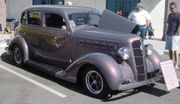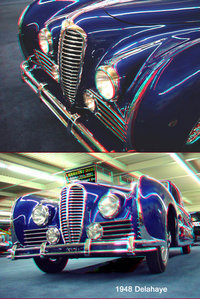Classic vehicles
Car Show
Classic vehicles
Brass Era vehicles | Vintage vehicles
 Ford
Model A Fordor
Ford
Model A Fordor
 1948
Buick Eight convertible
1948
Buick Eight convertible
 1955
Chevrolet Nomad
1955
Chevrolet Nomad
 1935
Plymouth PJ Touring Sedan
1935
Plymouth PJ Touring Sedan
 1948 Pontiac
Streamliner Sedan Coupe
1948 Pontiac
Streamliner Sedan Coupe
 1959
Chevrolet Impala
1959
Chevrolet Impala
Classic car is a term frequently used to describe an older
car,
but the exact meaning is subject to serious differences in opinion. One school,
the broader "antique car club" faction, are very inclusive. Almost any older car
in fine condition becomes a classic. The other extreme are the "Concourse de
Elegance" supporters, such as the CCCA, who think that only a few thousand
"Classic Era Motor Cars" even exist in good condition. They consider nothing
newer than 1948 to qualify...period.
The
Classic Car Club of America "claims" to have invented the term Classic
car and thus they believe that the true definition of the term is "theirs".
According to the CCCA:
- A CCCA Classic is a "fine" or "distinctive" automobile, either
American or foreign built, produced between 1925 and 1948. Generally, a
Classic was high-priced when new and was built in limited quantities. Other
factors, including engine displacement, custom coachwork and luxury
accessories, such as power brakes, power clutch, and "one-shot" or automatic
lubrication systems, help determine whether a car is considered to be a
Classic.
The Club keeps an exhaustive list of the vehicles they consider Classics, and
while any member may petition for a vehicle to join the list, such applications
are carefully scrutinised and rarely is a new vehicle type admitted.
This rather exclusive definition of a classic car is by no means universally
followed, however, and this is acknowledged by the CCCA: while they still
maintain the true definition of 'classic car' is theirs, they generally use
terms such as CCCA Classic or the trademarked Full Classic to
avoid confusion.
Legally, most states have time-based rules for the definition of "classic"
for purposes such as
antique vehicle registration; for example, Pennsylvania defines it as "A
motor vehicle, but not a reproduction thereof, manufactured at least 15 years
prior to the current year which has been maintained in or restored to a
condition which is substantially in conformity with manufacturer specifications
and appearance."
Alternate usage fundamentally equates Classic car with the definition
of
antique car as used by the
Antique Automobile Club of America, who define an Antique car as "anything"
over 25 years old. Thus, in this "broader usage" any car over 25 years old can
be called a 'classic car'.
25 years is generally considered a good cut-off age for such terms because
it's extremely rare for a vehicle that old to still be owned or used without
special consideration for its classic status — by 25 years old, a car will have
exceeded its design life by some considerable margin, 10-15 years being the norm
barring accidental loss. It will probably need significant maintenance to keep
running, and many parts will be hard to obtain through the usual channels. Thus,
a non-enthusiast will sensibly conclude that it is not feasible to continue
using a car that old for regular driving.
This is not to say that an enthusiast of classic cars might not drive such an
old vehicle daily, but that enthusiast will be willing to live with the greater
difficulty of so doing or the high cost of restoring the vehicle to reliable
condition.
Pre-"Slab-sided" style era, ending in 1948 vrs. all later models
There was a sea-change in styling in the period several years after the end
of World War II. The 1949 Ford, for example, utterly changed the traditional
discrete "replaceable" fender treatment and the radiator "semi-functional" look.
From this point on, automobiles of all kinds became "rounded boxes", in basic
plan. The CCCA term, "Classic Cars", over all this time, has been confined to
"the functionally traditional designs of the earlier period (mostly pre-war).
They tended to have "removable", fenders, trunk, headlights, and a usual
vertical grill treatment. In a Large vehicle, a Duesenberg or Pierce Arrow would
typify that class, where in a smaller form, the MG TC, traditional lines, might
typify the "CCCA" term. Since general antique car owners are "investors" it
serves the purposes of those clubs to classify a "new look" car as a classic.
Thus, it may be a "classic" example of a later period, but not a car from the
"Classic period of Design", in the opinion of the traditionalist CCCA faction.
Those of the "Antique Car", school of thought would include a 1980 "Anything",
that is "clean".
Latest look acceptable to CCCA definition
The CCCA era runs from 1925 to 1948. There is a certain continuity in the
over-all look to the bodies of these "Motor-cars". The French 1948 DelaHaye is a
good the example of a final year of "Classic Era Design".
 1948 DelaHaye
1948 DelaHaye
A partial list of the Marques (Brand names) of the cars that can be
considered "Classic" by the "traditionalist group".
Auburn - Bentley - BMW - Buick - Cadillac - Cord - Delahaye - Duesenberg -
Graham - Hispano-Suiza - Jaguar (car) - LaSalle - Lincoln (automobile) -
Mercedes Benz - MG (car) - Morgan - NSU - Packard - Pierce-Arrow - Renault -
Rolls Royce - Stutz
Home | Up | Antique cars | Brass Era car | Classic vehicles | Vintage cars
Car Show, made by MultiMedia | Free content and software
This guide is licensed under the GNU
Free Documentation License. It uses material from the Wikipedia.
|







